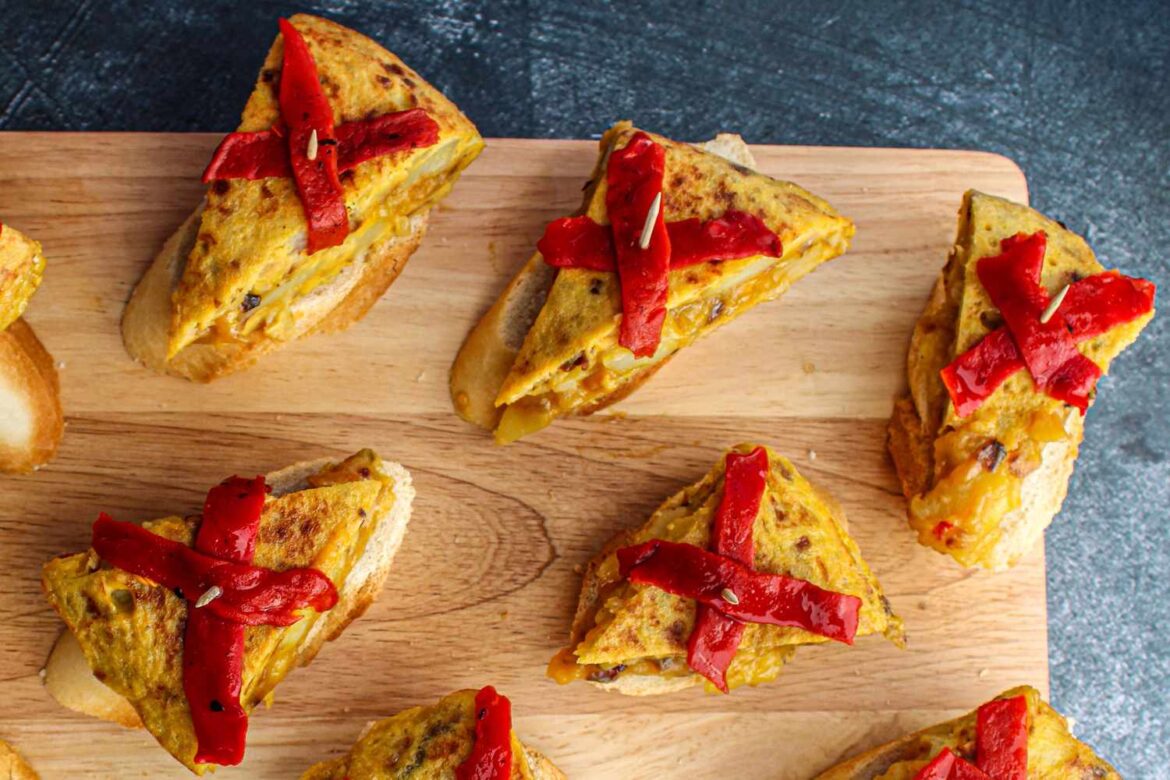Ask somebody if they want tapas for dinner, and they likely will get the idea — a fleet of Spanish-inspired small plates that are intended to be shared. Pintxos are a different story. Pronounced “PEEN-chose,” these bite-sized bar snacks are ubiquitous in the Basque Country of northern Spain, where they originated, but have largely flown under the radar outside the region.
Chefs would like to change that. “They are perfect cocktail party food,” says Katie Button, a 2011 F&W Best New Chef, who owns Cúrate in Asheville, North Carolina. Like tapas, pintxos are traditionally small bites, but their defining characteristic is how they are served.
2011 F&W Best New Chef Katie Button
“[With pinxtos], you get nonstop bites, conversation, and socializing, and you can do two things with two hands.”
— 2011 F&W Best New Chef Katie Button
“Pintxos are generally bites served on a skewer in a bustling, standing bar setting,” says Dom Crisp, chef and owner of Dom’s Taverna in Santa Barbara, California. This difference is reflected in their name: “Pintxo” comes from a Basque word derived from Spanish pinchar, or “to puncture”.
These skewered snacks don’t require silverware or even plates, making it easy to nosh and hold your drink simultaneously at a party. “You get nonstop bites, conversation, and socializing, and you can do two things with two hands,” says Button, who frequently hosts pintxo parties at Cúrate. “It’s very fun.”
If you’re looking to throw your own pintxo party, here’s everything you need to know about these Spanish appetizers: what they are and how to embrace pintxo culture at your next gathering.
What are typical pintxos?
Pinxtos are widely believed to have originated in the Basque city of San Sebastién in the early 20th century.
Although a skewer or toothpick is the classic pinxto’s defining trait, these small bites run the gamut in terms of ingredients and preparation. “The Gilda is probably the first pintxo that existed,” says Basque country-born Javier Canteras, chef and owner of Portland’s Urdaneta, which he named for his grandfather.
The Gilda was created in the 1940s at Bar Casa Vallés in San Sebastién and was named after the noir film starring Rita Hayworth. Traditionally it consists of a skewer of staple pantry items: a pickled guindilla pepper, a tinned anchovy fillet, and a pitted manzanilla olive.
A Gilda traditionally includes a pitted manzanilla olive, pickled guindilla pepper, and anchovy fillet on a skewer. It can also be made with other ingredients like pickled onions.
LUNAMARINA / Getty Images
A pintxo de tortilla takes a classic tortilla Española and renders it bite-size. “We cut it into small squares, and then top it with two different types of roasted peppers from the Basque country, one spicy and one sweet,” says Button. In the Basque town of Logroño, one of the most popular pintxos is a stack of garlicky sautéed mushroom caps at Bar Soriano.
“Now, pintxos don’t necessarily need to be on a skewer anymore. They can be more elaborate,” says Canteras. Still, they should be consumed in just a bite or two. “Matrimonio is probably one of my all time favorites,” he says. “It’s just a piece of toasted bread rubbed with a little garlic and tomato, then a boquerone (a white anchovy), and a salty Cantabrian anchovy.”
How to make pintxos
Pintxos don’t require recipes so much as a spirit of improvisation. “Basque food and tradition stems from finding wonderful local ingredients and putting them together with the intention of nourishing your loved ones,” says Crisp. “Don’t overthink it — get a nice crusty baguette, some butter or cheese, and quality tinned fish, and source different spiced and savory pickles,” he says. “Put them on the bread in different pairings and stab them with a toothpick, drizzled with olive oil, or sprinkled with smoked salt or shaved lemon zest.”
Dom Crisp, chef and owner of Dom’s Taverna
“Don’t overthink it — get a nice crusty baguette, some butter or cheese, and quality tinned fish, and source different spiced and savory pickles.”
— Dom Crisp, chef and owner of Dom’s Taverna
Button adds that you can look to your larder for inspiration.
“You’re creating these bites based on the combination of what you might have on hand or in your pantry,” says Button. “They truly can be anything.” Classic American hors d’oeuvres — think bacon-wrapped dates or deviled eggs — could be considered pinxtos.
Cooked pintxos also have a place in your spread, says Button. “You could make gambas al ajillo — sautéed shrimp with garlic — add a splash of sherry, and you could put it on a baguette and serve that.”
Tips for throwing a pintxo party
For a Basque-inspired gathering, Button advises a DIY approach: “Make your own pintxo bar and let people make their own.”
There are no limits to the number of pinxtos you can serve. Just consider the size of your party, as well as the appetites of your guests.
“If I was throwing a party, I might serve 10 different pintxos, including meat, seafood, and vegetable options, but you could do four to six for a smaller gathering, with one to two of each pintxo per person depending on how popular you think that particular item would be,” says Button.
Most pintxos can be made ahead of time and served at room temperature, so you can also relax and enjoy the festivities along with your guests. “Then quaff vermouth, dry cider, or txakoli, poured from up high into a large glass,” says Crisp. “See who can build a house with their toothpicks at the end. This is pintxo culture.”

